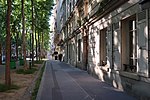Institut des hautes études de défense nationale
The Institut des hautes études de défense nationale (IHEDN) (Institute of Advanced Studies in National Defence) is a French public academic institution for research, education and promotion of expertise and sensitization towards defence matters, founded in 1936 by Admiral Raoul Castex. Originally it was the Collège des hautes études de défense nationale and was renamed an institute in 1948. To the original national training sessions were added sessions in the regions (1954), international sessions (1980), economic intelligence cycles (1995), and other targeted seminars. In 1997 the Institute became a public administrative establishment placed under the authority of the Prime Minister. In 2010 it merged with the DGA's (Direction générale de l'armement) Centre des hautes études de l’armement (Centre for Higher Armament Studies (CHEAr)). The Institute is located in the École Militaire. The vocation of the Institute is to train high-level military, government officials and high-ranking executives in defence matters. Some sessions are reserved for young auditors, generally students in the foremost grandes écoles, and under the age of 30. In 2010, the deputy director of the defense college was Robert Ranquet.
Excerpt from the Wikipedia article Institut des hautes études de défense nationale (License: CC BY-SA 3.0, Authors).Institut des hautes études de défense nationale
Place de Fontenoy - UNESCO, Paris 7th Arrondissement (Paris)
Geographical coordinates (GPS) Address Nearby Places Show on map
Geographical coordinates (GPS)
| Latitude | Longitude |
|---|---|
| N 48.8525 ° | E 2.3034 ° |
Address
École Militaire
Place de Fontenoy - UNESCO
75007 Paris, 7th Arrondissement (Paris)
Ile-de-France, France
Open on Google Maps










